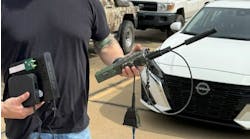Latest from Core/Legacy
Two of the large Telco operating companies have taken a stand on the use of high voltage to ionize wet pulp cable faults and the use of high current to weld a solid short on the telephone cable pair. After this process is completed, a distance to the fault can be measured and a tone can be applied to locate the exact location of the fault. Their statement is as follows:
The Edict From Staff
Based on safety and equipment damage concerns, the use of high voltage/high current test sets in our network is prohibited. The Breakdown test set(s) should no longer be used under any circumstances. All Breakdown test sets should be removed from the field and retired. The TONE ARC set may be used only to apply tone to a cable pair and should never be used to apply excessive voltage/current. Trouble Isolation shall be performed using Time Domain Reflectometer (TDR), Resistance Fault Locating (RFL) and/or the ToneRanger test set.
The RBOC’s stand is absolutely justified in my mind, but the fault is not the use of the breakdown test set or the TONE ARC, but the misuse of the test sets and not following proper safety procedures.
The breakdown test set is the primary tool used to rapidly find wet pulp cable faults. It has been a proven reliable test set and safe if properly used and proper safety practices are followed. It is misuse and misunderstanding of the fault locating process that is creating the downfall of this valuable and cost-effective test set.
When I began in the telephone business in the early 1960s, 90 percent of our telephone cables were paper- and pulp-insulated. Plastic was in its infancy. The breakdown test set was in the hands of every cable maintenance technician in the industry. On any rainy day, the field technician applied breakdown voltage to find and fix a minimum of 5 wet pulp cables.
In today’s environment, the majority of telephone distribution cables are plastic insulated conductors (PIC). There are still untold thousands of feet of pulp- and paper-insulated feeder cables. They will be in use until every duct leaving a central office is free of copper and filled with fiber.
Major pulp and paper cable disasters have been averted because of good air pressure policies by large operating Telcos. A quality air pressure program mitigates wet pulp cables in conduit runs. Keep in mind that some of those old cables are lead sheath and are susceptible to electrolysis; splices leak; and air pressure is not properly maintained. These pulp cables will get wet putting countless customers out of service.
Managers
My first comment is to the management team: When you lose a large pulp cable do not panic if it takes hours or even days to find the location of any wet pulp cable, especially a large count wet pulp cable — when the damaged spot could have been found in less than an hour using the old techniques for fault locating in pulp and paper cables.
You are going to have to bite the bullet. Use the techniques described by your staff managers to locate pulp cable faults. The ToneRanger will tone to a wet pulp cable, but there is no way to get a measurement showing the distance to the fault. The resistance bridge needs a good clean cable pair and the Time Domain Reflectometer (TDR) cannot show a short that is not solid metal touching metal.
Field Technicians
My second comment is to craft field technicians: Immediately turn in all breakdown test sets and TONEARCS. You are paying for the sins of the untrained and uninformed technicians who attempted to use the breakdown test set in PIC cables with no success, and burned one side to ground destroying equipment and putting other technicians and customers at risk of being in contact with high voltage.
If you hide the breakdown test set or TONEARC, no alternative method will be designed to rapidly find those wet pulp cables. Document the time and effort it takes to locate pulp cable wets because of the inability to get distance to fault measurements. You will be called on the carpet for taking too much time to restore service.
In order to tone to a solid fault with the TONEARC, the high voltage is still applied. If the voltage is disabled, the set will not send tone. The alternative for solid shorted, grounded, and crossed cable pairs is to use a precision tone generator such as the TriTone Precision Tone Generator manufactured by AA logic
(www.aalogic.com/tritonemain.html).
It is known that as little as 1/2 of 1 amp can destroy sensitive electronic equipment. This unwanted voltage comes from other circuits in the cable especially power pairs, T1, and HDSL circuits if there is cable damage or wet splices. The root cause of this unwanted voltage must be proactively removed rather than reactively transferring cable pairs to restore service.
As an aside, in the field environment there are countless sources of AC voltage that can kill you. Use your voltage tester with a vengeance. Test anything that has a possibility of hazardous voltage.
Signing Off
It’s early but not too early to plan for OSP EXPO 2011, the leader in OSP education. Tell your boss this is a must-attend event: September 12-14 in Cincinnati, Ohio. I’ll be presenting and you can challenge me with any questions — I love being stumped! This year promises to be one of the best OSP EXPOs ever. Get the details at www.ospmag.com/expo.




